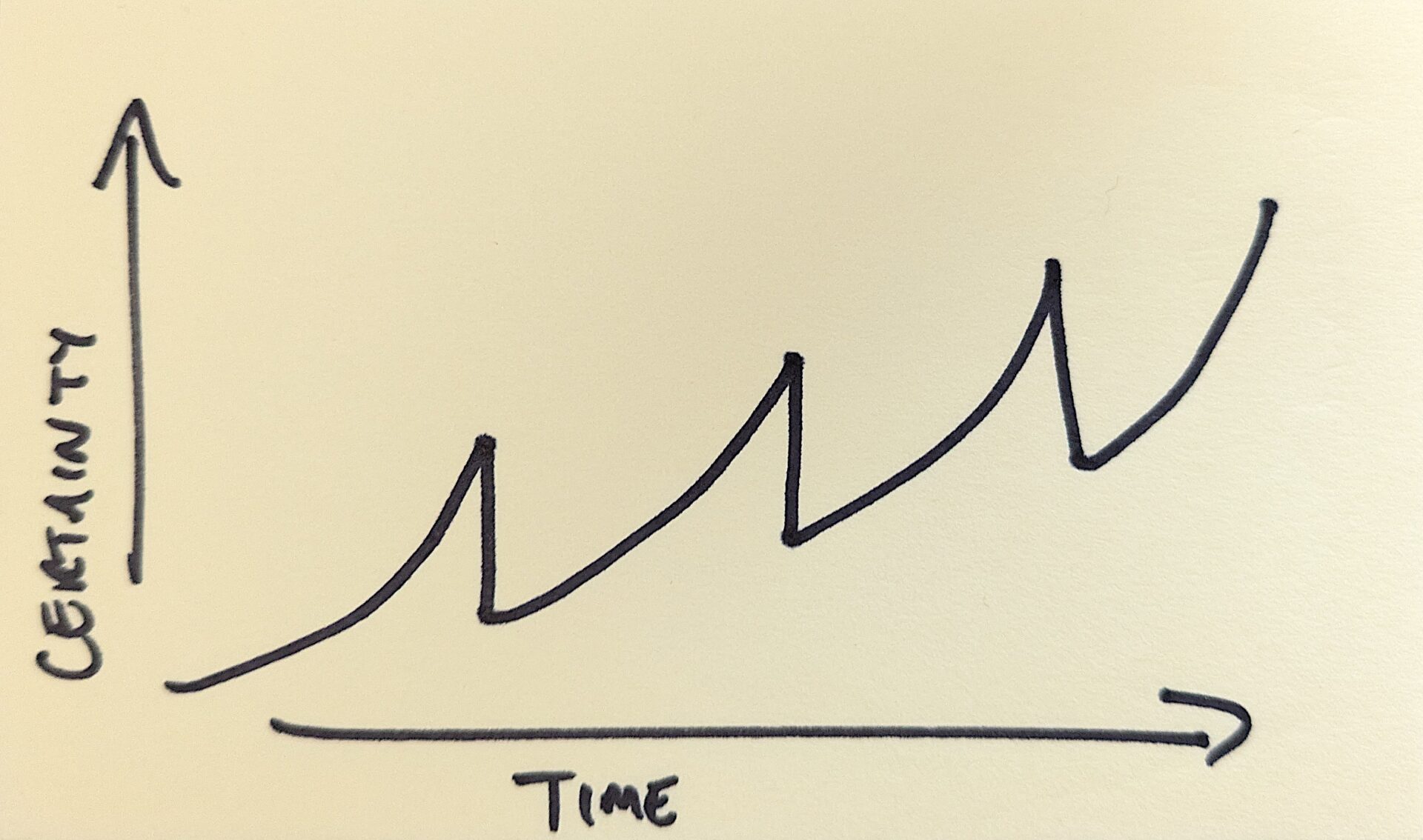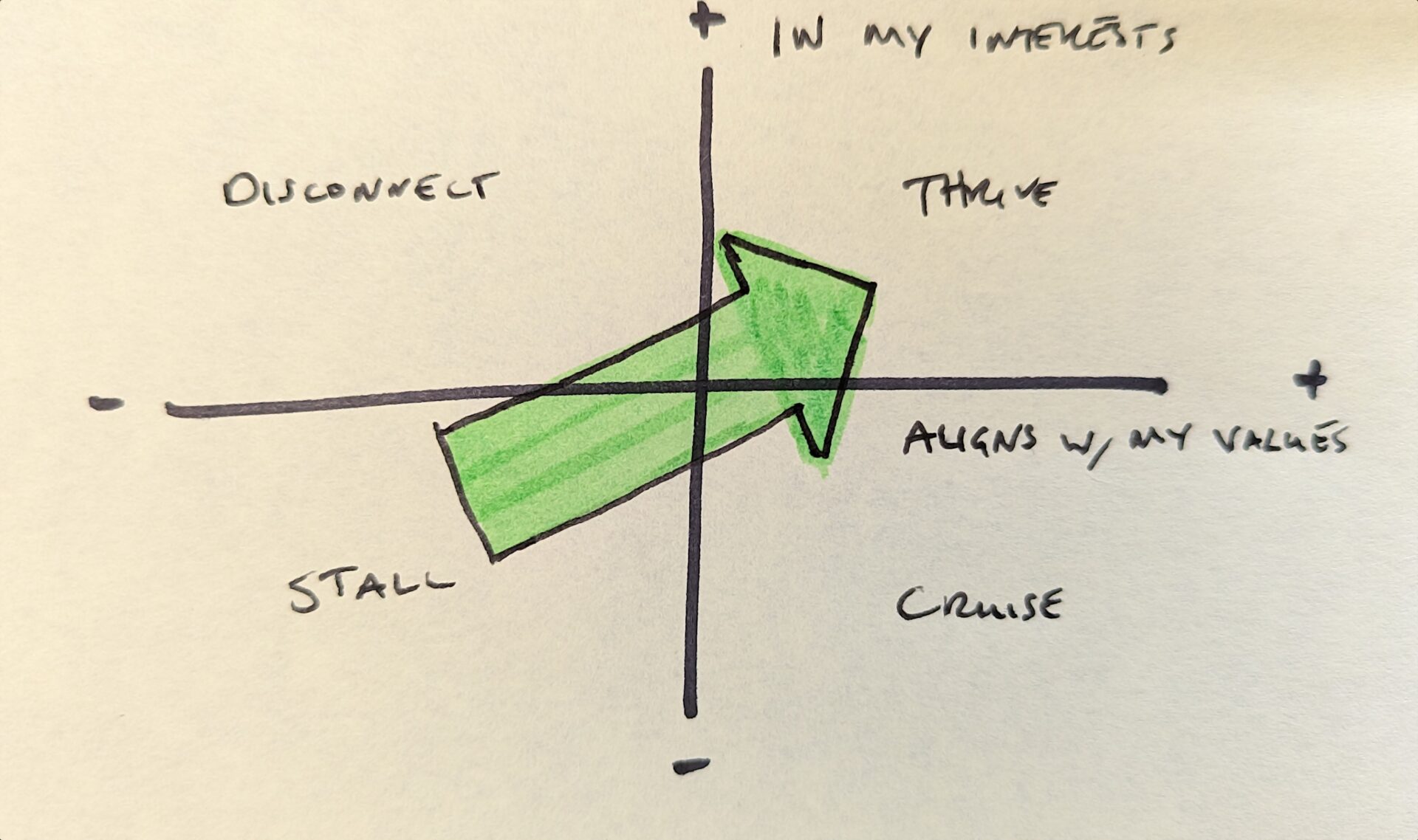
PRODUCTHEAD: Finishing versus starting
PRODUCTHEAD is a regular newsletter of product management goodness,
curated by Jock Busuttil.
street product (fade out) #
every PRODUCTHEAD edition is online for you to refer back to
tl;dr
If context is continually changing, aim for incremental progress and let go of perfectionism
Balance the need for action with the drive to understand both the problem and your biases
Change is like a sledge stuck in the ice: hard to get moving, but easier to keep moving once freed
hello
There’s quite a dramatic gear change between wrapping up a body of work and starting the next one, particularly if you and your team have been working well together.
What did flow feel like? #
Think about a significant body of work you and your team completed together successfully. One that was spread over several months. One that was focused on a single overarching goal (= outcome, a change in how people do things), even if the actual work was varied and spread across many different areas.
If you have an example in mind, towards the end you may have noticed some or all of the following:
- the goal of the work had been well communicated and was well understood;
- stakeholders appreciated the value of the desired outcome and understood why you’d chosen to do it the way you did;
- you and your team were very closely aligned on the why, what and how of the work, as well as the measures of success, and working together well as tight-knit unit.
I’m guessing it didn’t start out this way. You and your team built steadily towards this end-state over time.
An abrupt change #
Towards the end of a body of work that’s been going well, you have a comparatively high level of certainty. You’ve already answered the big questions, and so now it’s all about just getting it done. Your team may also be working in a state of flow: the ‘machine’ is well-oiled. This state of flow has natural inertia: it feels easier to keep delivering than to change; just keep feeding the team with things to do.
However, on completion the nature of the work fundamentally needs to change. You are starting again with a new desired outcome and its associated set of challenges. You’ve gone back to a position where you and your team know comparatively little; certainty is low(er) again.
That inertia you’ve built up — you and your team’s desire not to lose that state of flow — can now work against you if you’re not conscious of it. Despite no longer having known and certain things to build, it’s tempting just to keep delivering. Only now you’re adding less and less useful product features like the proverbial feature factory.
Starting the next thing, even if it builds on the previous work, means shifting mindset from out ‘delivery of the certain’ to ‘learning about the uncertain’. You have to consciously rein in that delivery inertia and re-establish a new state of flow for discovery, experimentation and learning.
I visualise this as a rising saw-tooth pattern of certainty against time. After a gradual build-up, the most abrupt change comes at the end of a body of work. But you don’t quite reset back to zero each time because you carry over some knowledge from phase to phase.

A conscious reset #
Because of this, I believe it’s important for teams to consciously and deliberately reset for the next body of work. That way they don’t slip back prematurely into delivery mode.
Think about what and your team should do to get back into that state of flow. To start with, work to ensure:
- you have communicated the goal of the work effectively and everyone understands it;
- your stakeholders appreciate the value of the desired outcome (to users, to them, to the wider organisation) and understand why you’re going about it that way; and
- you and your team are very closely aligned on the why, what and how of the work, as well as the measures of success, and are working together well as tight-knit unit.
For you this week #
Rebecca Zucker and Darin Rowell wrote “6 Strategies for Leading Through Uncertainty” for Harvard Business Review in 2021. There’s also a concise accompanying video, which summarises the key points in a few minutes.
I’ve been reading Chris Hirst’s recent-ish book, No Bullsh*t Change (you may have read his earlier one on leadership). As with his other book, its strength lies in the end of chapter summaries; I also like his breakdown of individual motivations (see pic below).

He does however assume that the reader is a CEO or managing director with a mandate to drive the change in the first place. So less directly applicable for those of us who work through influence rather than direct authority. Not a criticism of the book, just a reflection of Hirst’s intended audience.
Speak to you soon,
Jock
I’ve included affliate links to Amazon this week, so if you were to purchase something I would receive a small commission.
what to think about this week
6 strategies for leading through uncertainty
It seems that any given week provides ample reminders that leaders cannot control the degree of change, uncertainty, and complexity we face. The authors offer six strategies to improve a leader’s ability to learn, grow, and more effectively navigate the increasing complexity of our world.
[Rebecca Zucker & Darin Rowell / Harvard Business Review]
No Bullsh*t Change: An 8 Step Guide for Leaders
Drawing on an international career of leading successful change programmes, Chris Hirst cuts through the bullsh*t to reveal uncomplicated strategies for transformation — no matter the size of your organisation or the nature of the challenge. Leading change is about:
- Being honest and clear
- Building teams full of thriving people
- Finding your point of maximum impact
[Chris Hirst]
recent posts
Moving up to a CPO or VP Product role
Stepping up to a Chief Product Officer (CPO) or VP Product role doesn’t so much change what you do. Rather it amplifies everything. This guide lets you know what to expect.
Liberating and terrifying in equal measure
[I Manage Products]
I want to update my pricing strategy. Where do I start?
“My product currently has one tier of per-seat pricing for all customers. I want to change my pricing strategy to cater differently for SMEs and enterprise customers. Where do I start?”
A few pricing concepts to consider + further reading
[I Manage Products]
How do I make my product roadmap a better communication tool?
“My product roadmap is not getting the right information across to other people in my company. In particular, my customer success and marketing teams are struggling to plan their work for upcoming product releases. I’m also not sure how I can show my roadmap’s relationship to the half-yearly OKRs we set. How can I improve it?”
Your product roadmap is a communication tool
[I Manage Products]
can we help you?
Product People is a product management services company. We can help you through consultancy, training and coaching. Just contact us if you need our help!
Helping people build better products, more successfully, since 2012.
PRODUCTHEAD is a newsletter for product people of all varieties, and is lovingly crafted from screechy school violins.

